How we won second place in the 2014 MATEC ROV competition in the USA
Hi, my name is Michael, I am a student of the Faculty of Informatics and Control Systems at Moscow State Technical University. Bauman. Not so long ago, I was able to participate in international competitions of underwater vehicles MATEC ROV ompetition as part of a university team. I would like to talk about it, especially since very few people know about such competitions. On Habré there was already a publication about these competitions from one of the participants, but for various reasons it was deleted. Here I will try to tell in more detail about my involvement in the project, about preparing the team for the competitions during the year and about the competitions themselves, which took place in June in the city of Alpena, Michigan, USA.
Under the cut a lot of photos.

Our laboratory on a typical day.
My classmate is studying at the department of underwater robots at MSTU. N. E. Bauman. A little after the new year, I receive a message from him with a proposal to participate in the project of an underwater robot for the competition as a programmer of microcontrollers, due to the fact that no one in their team has ever programmed. Since I didn’t have any plans for independent work for the coming semester, I agreed with pleasure, in the end, I finally had the opportunity to do something real that you can touch and what goes beyond home crafts. It turned out that at our institute for several years now the “Hydronavtika” center has been operating, the activity of which is mainly focused on preparing and participating in competitions from the organization Marine Advanced Technology Education Center (MATE) on the subject of underwater remote-controlled vehicles (remotely operated underwater vehicle). English-language literature is traditionally abbreviated as ROV). It should be noted that the laboratory of the center is equipped in principle with everything that is needed for productive work: an oscilloscope, soldering stations, various machines and tools, as well as its own small pool with a water filtration system. Without it, it would be very difficult, because would have to run every time in the pool of the university sports complex, if necessary.
')

Tests of the robot in our home pool
After a short chat with my friend, we agreed to meet with the other guys in their lab. The guys were very nice and positive. After a brief discussion of the current state of the project and the competition itself, it was decided that I would participate.
More information about the competitions can be found on the official website . In short, the competition consists of passing through several stages. First, you need to get the approval of the organizers of the competition about your participation, for this you need to prepare a number of documents, for example, a technical report with a detailed description of the device. You also need a month before the performance to provide a video with a demonstration of the apparatus, to show that he can swim at all and perform at least some tasks under water. After passing the preparatory stages and obtaining the approval of the organizers, you can go to the competition. As with all such activities, the task set changes annually.
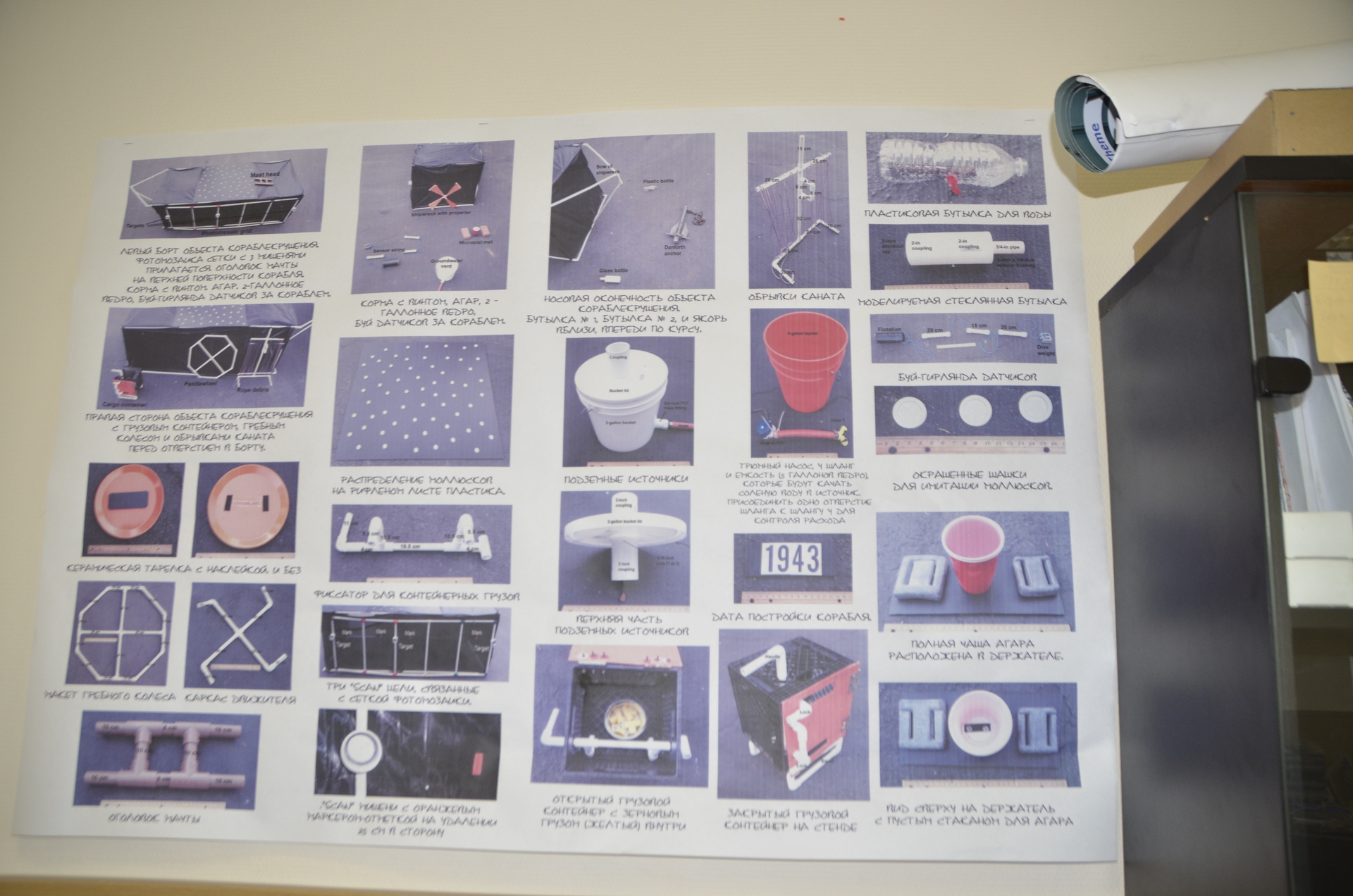
A list of all tasks on the wall of the laboratory
Each year, competitions have a specific theme related to real problems and tasks in the waters, which require underwater vehicles to solve. This year the task was to study the bottom of one of the Great American Lakes, namely Lake Huron. At the bottom of the lake, in untouched form, there are many sunken ships. The mission of the device consisted of three stages: the study of a shipwreck, scientific research at the bottom, cleaning the bottom from debris. Of course, the competition itself is only a simulation of the real situation, so the vehicles floated not in the lake, but in a deep pool, at the bottom of which a shipwreck and other bottom equipment was displayed. In the first stage, it was necessary to investigate the shipwreck zone in order to determine the type of the ship, the year of its construction, the port of registry, which will allow it to be identified uniquely. The second stage includes such tasks as counting the number of mollusks that have grown to the surface of the ship, determining the conductivity of water spurting from an underwater source and lifting from the bottom of gel-like biomaterial samples.

Slightly stagnant and therefore moldy glasses with jelly for testing
In the third stage, it was necessary to pick up trash (glass and plastic bottles) from the bottom of the lake, as well as a heavy steel anchor of the sunken ship.
It should be noted that successfully completing all the tasks under water is not enough to win. Underwater missions “cost” only 320 points out of a total of 600. Competitions are structured in such a way that teams are required to present themselves on the site of private companies participating in a tender for underwater work. That is, each team must successfully present itself to the judges and justify why it is their staff and their team will be able to carry out the work most successfully. This part of the competition is called “Engineering and Communication” and also consists of 3 items - a technical report, an engineering presentation and a poster.
The technical report is a 25-page document containing a detailed description of the apparatus and the process of its development, its technical features (“features”), which will ensure the successful fulfillment of the underwater mission. This document must be prepared about a month before the competition and sent to the judges. For technical report you can get up to 100 points.
On the poster, the team should be concise, but colorfully fit the information about the team and the staff. Posters are also evaluated by the judges during the competition, for them the team can get up to 50 points.
Engineering presentation is an oral presentation of the team in front of a panel of expert judges, with a story about the advantages of the device over its competitors. The presentation is worth 100 points.
The remaining 30 points are given to those teams that from the first time passed the test of their apparatus for safety and compliance with the regulations.
Thus, only careful preparation of all points can bring the team victory.
At the time of accepting me into the project, and let me remind you, it was somewhere the beginning of February or even later, things were not too good: the previous team graduated, and only 2 people were left from it, who at least somehow imagined how everything should be. The new team, unfortunately, was practically without work experience, for many it was the first real project. The old team left behind a working robot, and working perfectly. But, unfortunately, participation in the competition with one robot two times in a row is not welcome, so the task of the new team was to develop and assemble a new robot. Also, the first semester of this academic year was spent almost completely empty, and only half a year was left before the competition, which, given the general academic load, is quite a short time.
My tasks in the project included writing software for on-board electronics, which was based on the Arduino platform. This choice was justified by the fact that most of the participants only learned programming, and such a platform was the best choice. I, as an amateur of pure MK programming, although at first resisted, but in the end I agreed with this choice, since all the boards were already developed for the Arduin and there was no time left to change something.
Actually, this is how it all started, unfortunately, for quite a long time I was up to date and only after almost a month and a half until the end I understood how everything should look in the end. Again, the study load, which did not allow to work in full force, affected.
Now a little about the technical details. The electronics of our robot was a tower of several round printed double-sided boards, placed a cylindrical plexiglass case, closed on both sides with sealed covers.

Two parts of the electronics tower in parsing
Fastening the covers of the electronics housing occurs without screws, thus assembling / disassembling can be done quite quickly. All boards have the same connectors with the same pinout, thus eliminating the possibility of improper assembly. This concept was taken from the previous robot and, in my opinion, is very convenient in this situation. The tower consists of the main controller board — the Arduino Mega, the screw driver driver board, the secondary power supply board, the fixture control board (manipulators, light, pressure sensor, camera drive), two interface boards with sealed connectors, one on each side. The robot itself has 8 rotor motors located vectorially: 4 vertical, 4 horizontal.

Upper part of the body of the robot. One vertical and two horizontal propellers are visible.
There is also a camera box in which there are 2 cameras, one for the pilot, one for the image processing system. Also there are 2 manipulators and light.
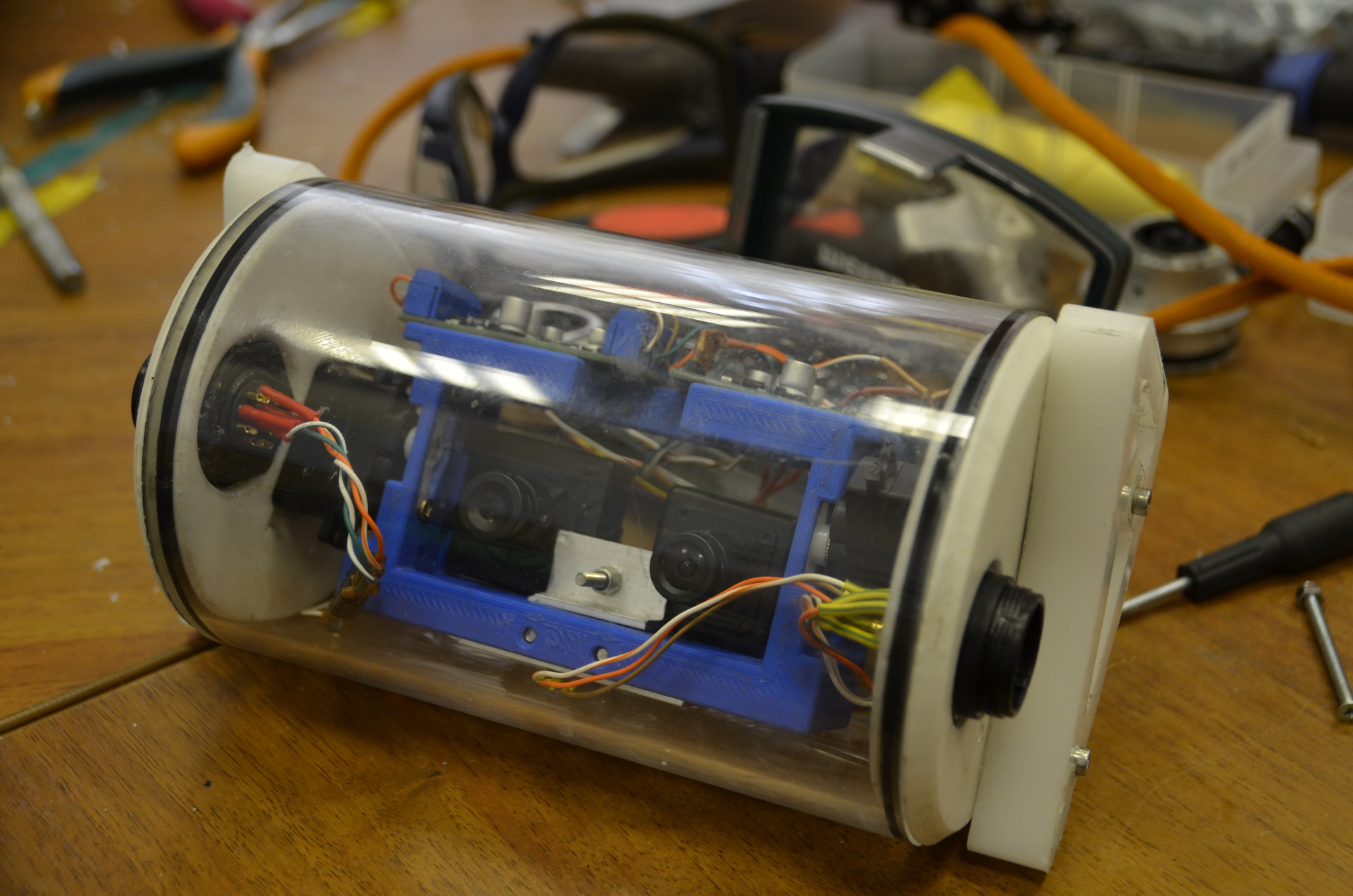
Camera body, still raw version
Orientation in space and stabilization is performed using a Vectornav VN-100 sensor. Communication with the robot takes place via the RS-485 interface, using a simple protocol developed by us. There is also a control panel, left over from the previous command, with 2 kW power supplies, built-in PC, 3D monitor for video from cameras and a small touch screen for drawing the dashboard.

Remote Control
Parallel to the development, assembly and testing of various parts of the robot, there was registration for competitions, documentation, and so on. In early May, we had an interview at the US embassy to get a visa. This event was significant not only because most of us sent for an additional check, but also because the next day I learned that due to the fact that we did not have time to finish and debug the current electronics, it was decided to use electronics from previous robot, as it is fully operational. In principle, the decision was quite logical, although it was a bit annoying, since by that time the new electronics was 60-70 percent ready, that is, it was the orientation, controls of the screw motors, grippers, lights, camera positions.

The result of several months of work remaining in Moscow. Tulip inside turned out to be random
But there was a wrong situation to defend my results, so I was quickly transferred to another task - the conductivity sensor. At the beginning it was assumed that this would be a small unit with a sensor sticking out of it, which the pilot would install in an imitation of a hydrothermal source. However, later the design was slightly changed, leaving the data processing unit on the shore, and only the sensor cell was lowered to the bottom. For those who do not know, the water conductivity sensor consists of two graphite rods, between which alternating current is allowed. Variable — to prevent ions from sticking to the rods. Then, from one rod, this alternating voltage is fed through a diode to the ADC, where the voltage level is measured and further processed to obtain the conductivity value. They did the circuit design themselves - they assembled it on a breadboard, they looked at how it seemed to work. I was required to write the software for the arduine of the nano standing in the block, that is, to organize the measurement of the voltage level through the ADC and the delivery of this data to a computer, for which I also had to write the software for display on the screen. It was also necessary to place a temperature sensor inside the conductivity sensor to adjust the conductivity value.

Conductor measuring device just completed
The funny thing is that almost before leaving and after the heap of time spent on making the temperature sensor work normally, it turned out that it is not needed, since the condition requires determining conductivity in general, at the current time, and this value does not depend on temperature . In principle, it was one of the many shoals we committed while working on the project. Despite the simplicity of the sensor, I spent a lot of time on it. Since, in addition to a slightly clumsy analog circuit, it seems that there was some kind of life of its own, there were a lot of other problems, such as the temperature sensor and glitches of the USB-UART adapter. The software for processing data from the sensor was done literally until the last moment, but more on that later.
After the robot was assembled (mid-end of May), we went swimming in the pool several times, then we must thank the administration of our university for contributing to the allocation of paths in the pool of the sports complex.
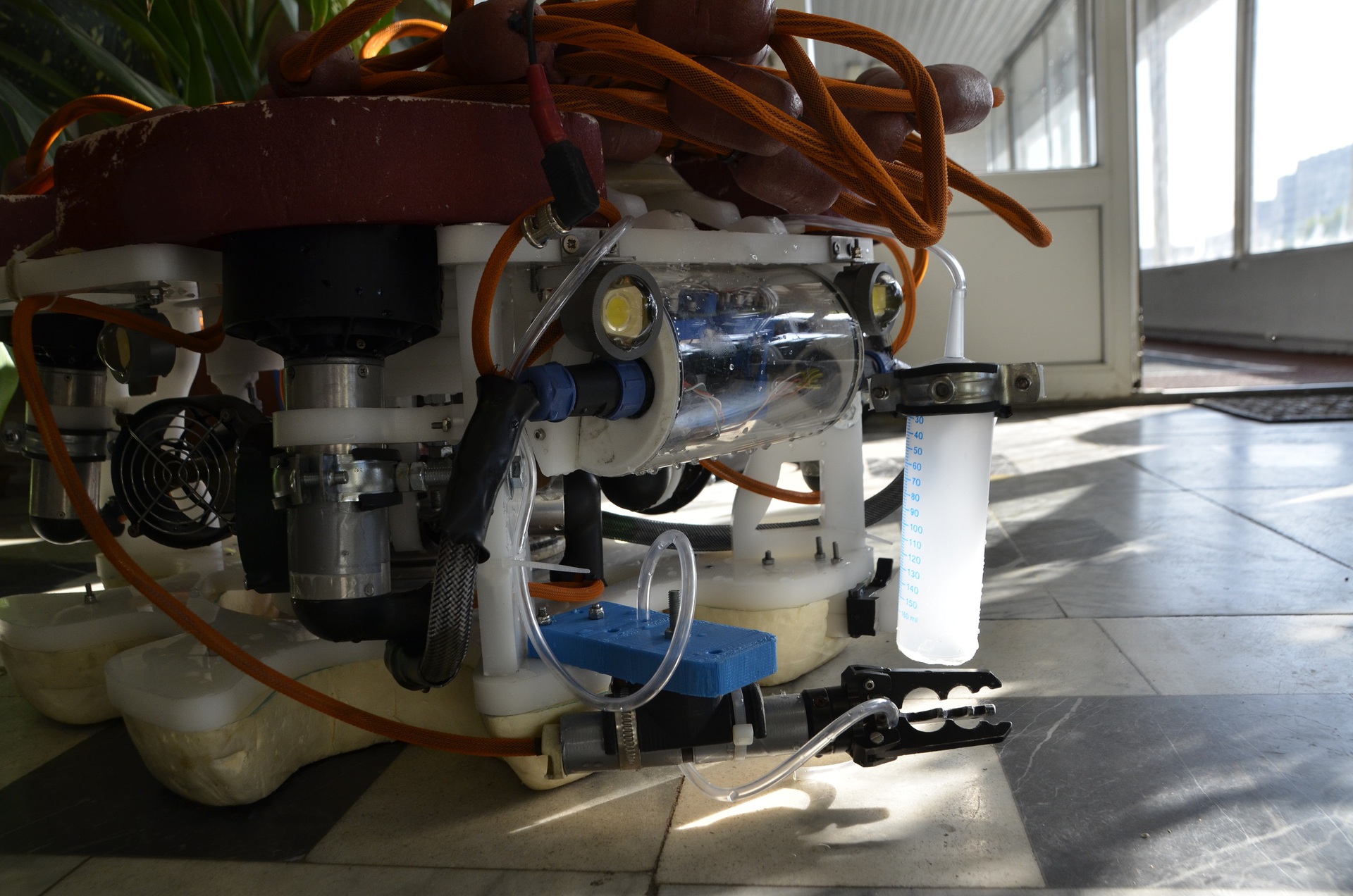
Final option
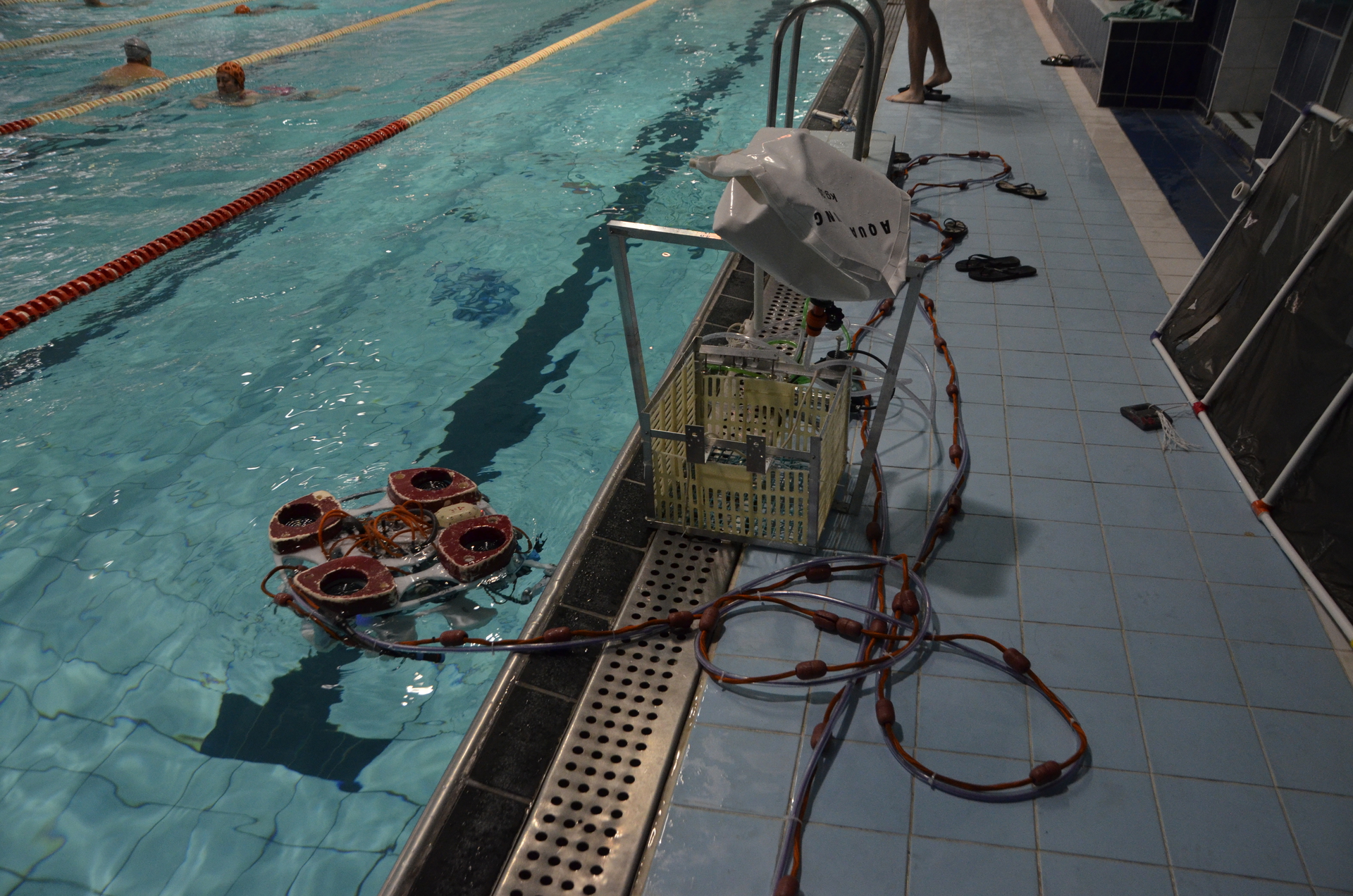
Workout shortly before departure. The main thing was not to forget slippers
There were a lot of problems on the test: leaks, loss of communication and burned-down boards. So, once the video link disappeared. Having examined the block of cameras, they saw a dead diode on the video signal conversion board of the video camera. The solution is to replace the cable with a shielded twisted pair. It also eliminated noise in the analog video signal.
Once a leak caused a complete burnout of the power tracks on the driver and, accordingly, the engine shutdown. We noticed it not immediately, because the robot remained operational, there was simply no thrust through the lag (the lag is a plane-parallel movement along the transverse axis). At first they thought that the screw flew off the shaft mounting, however, when they came to the laboratory, they found that everything was much sadder.

Burnt from KZ short circuits
And so on. As a result, it turned out that at the time of departure we could not conduct a single full-fledged training of the team and the execution of all the missions for the time set. It was also interesting that during the training sessions in our pool, the pilot constantly had to cope with undercurrents, which were often quite strong and very much hampered the execution of tasks. But, as it turned out, it was difficult to learn - it was easy to fight, and there were no currents in the pool where the competitions took place, so it was much easier for our pilot to complete the tasks.
The week before departure, as expected, was quite intense. Besides the fact that many had exams, it was necessary to still prepare for departure. Various devices, details of the robot, my sensor and a lot of other things were quickly completed. On the day of departure, while the guys were sorting out and packing the robot in their suitcases, I went shopping to buy more trash.
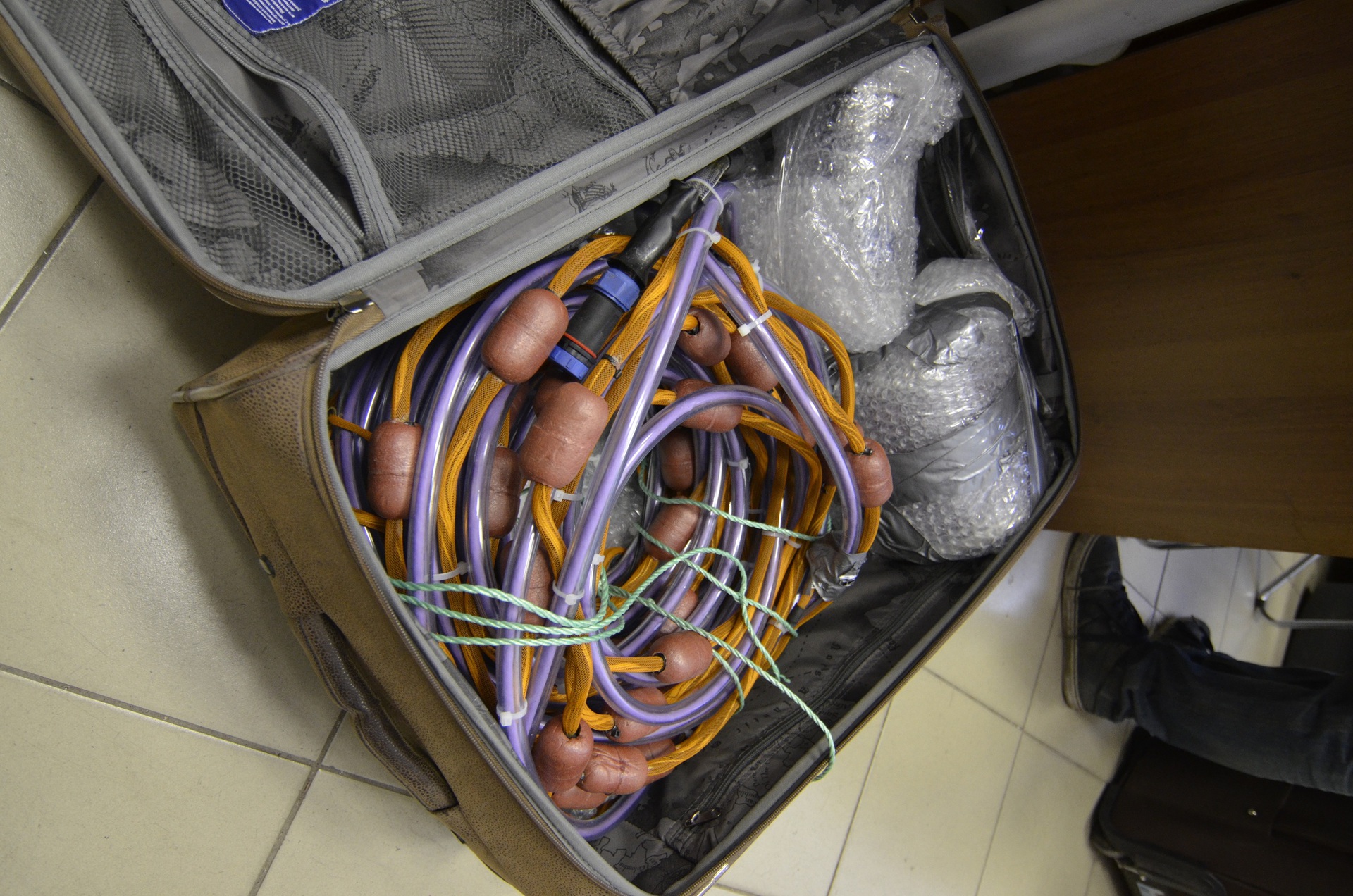
Packing suitcases. It is very important that everything is intact.
It's funny that both times, when I left the university, I fell under a wild downpour, which ended after 20 minutes. We had a plane at five in the morning, so we spent the whole previous day collecting in the laboratory to go to the airport at night and fly away in the morning. In addition to the robot, we carried tools, an oscilloscope, a set of spare parts for the robot, and a whole lot more. I was very worried about overloading, because the dynamometer on that day was one of the main tools. The guys urgently printed a poster and prepared the documents that we will show to the judges. In the end, after reaching the university car to Sheremetyevo and meeting the rest of the guys there, having safely handed over our suitcases to the luggage, having paid a couple of overloads, we flew to Amsterdam.

5 hours before departure
In Amsterdam, a very short transfer was waiting for us; in the end, after a light jog from one gate to another and a relaxed conversation with security officers, we ended up on a plane flying to Detroit.
Competitions are held every year in the new city, the last time they were in the Federal Way town in the suburbs of Seattle, this time we were less fortunate and the provincial town of Alpena in northern Michigan, right on the shore of Lake Huron, was waiting for us. For me, this was the first visit to America and, unlike most people visiting this country for the first time, my acquaintance with it began with the real heartland.
10 thousand people live in Alpena, which is almost ten times less than in my hometown. So the international competition of this level for the city was really a big event. I will not describe my impressions of what I saw, I think it will interest few people. I will say one thing: I really liked the city and its inhabitants. Maybe the Americans are smiling at everyone, but the people we met on the street, having learned that we are one of the teams, and even more so from Russia, smiled and sincerely wished us luck.
So, arriving in Detroit, we quickly took 2 rented cars and drove to Alpena. After almost 5 hours, the roads finally reached our hotel. Since Alpena is a tiny town, there are only two hotels, in which the participants of the competition are located quite evenly. Teams from America, Indonesia, China and Canada lived with us in the hotel. The first day was completely busy assembling a robot. Each team did it in its own way: who was lucky and whose numbers went inside, settled right in the interior, who were not lucky and the rooms were outside, collected the robot in the rooms.
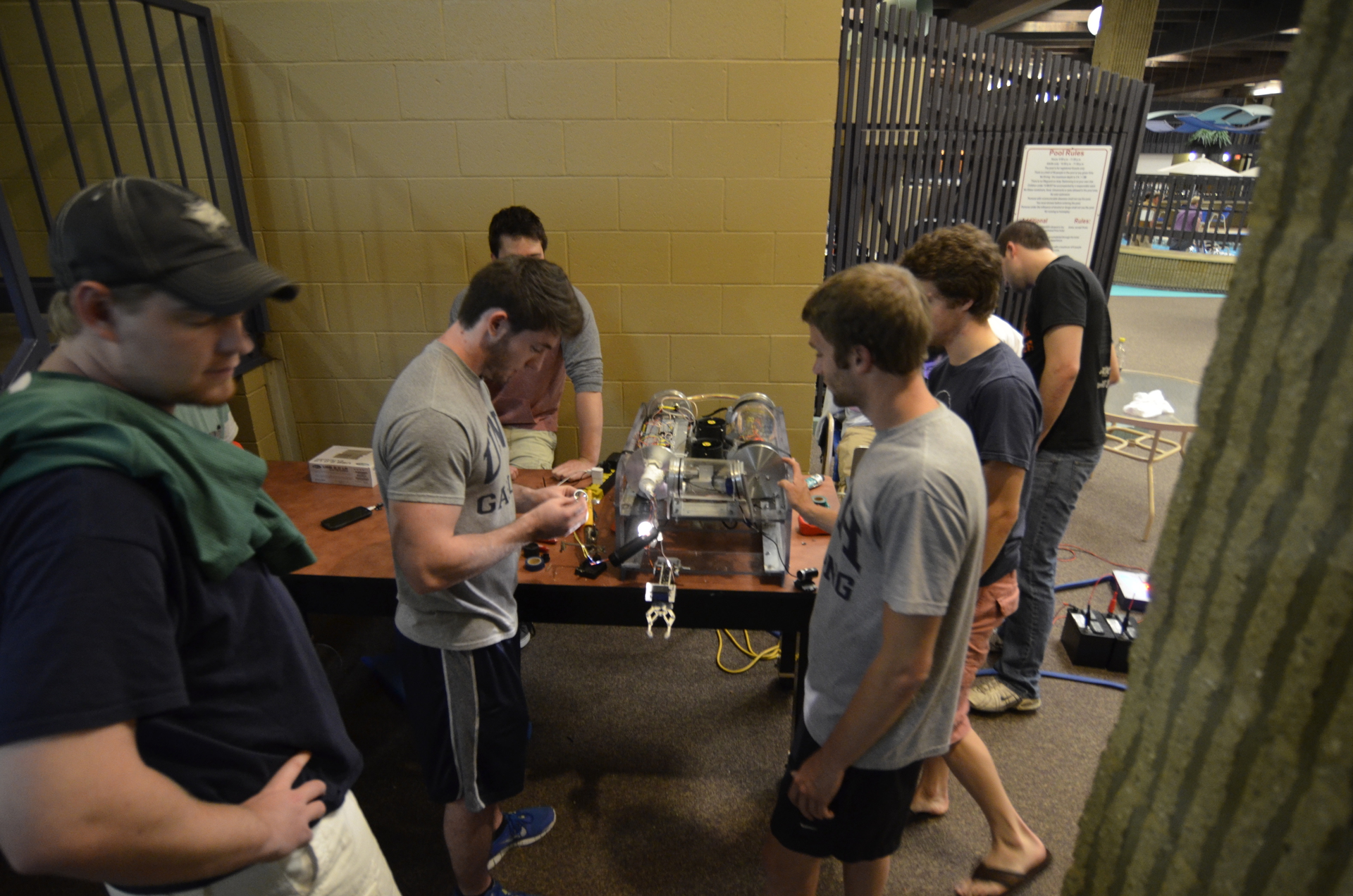
These guys are lucky, they have a big table and a lot of space.
We were less fortunate. As expected, one room turned into a small workshop, where someone was always doing something.

Although we do not have a large table, but it was cozier
In the absence of an accessible pool, the sealing of the robot was checked in the bathroom.
We spent the entire first and second days at the hotel, collecting robots and gadgets for it, only having gone to eat a couple of times, to the store for details and to register.
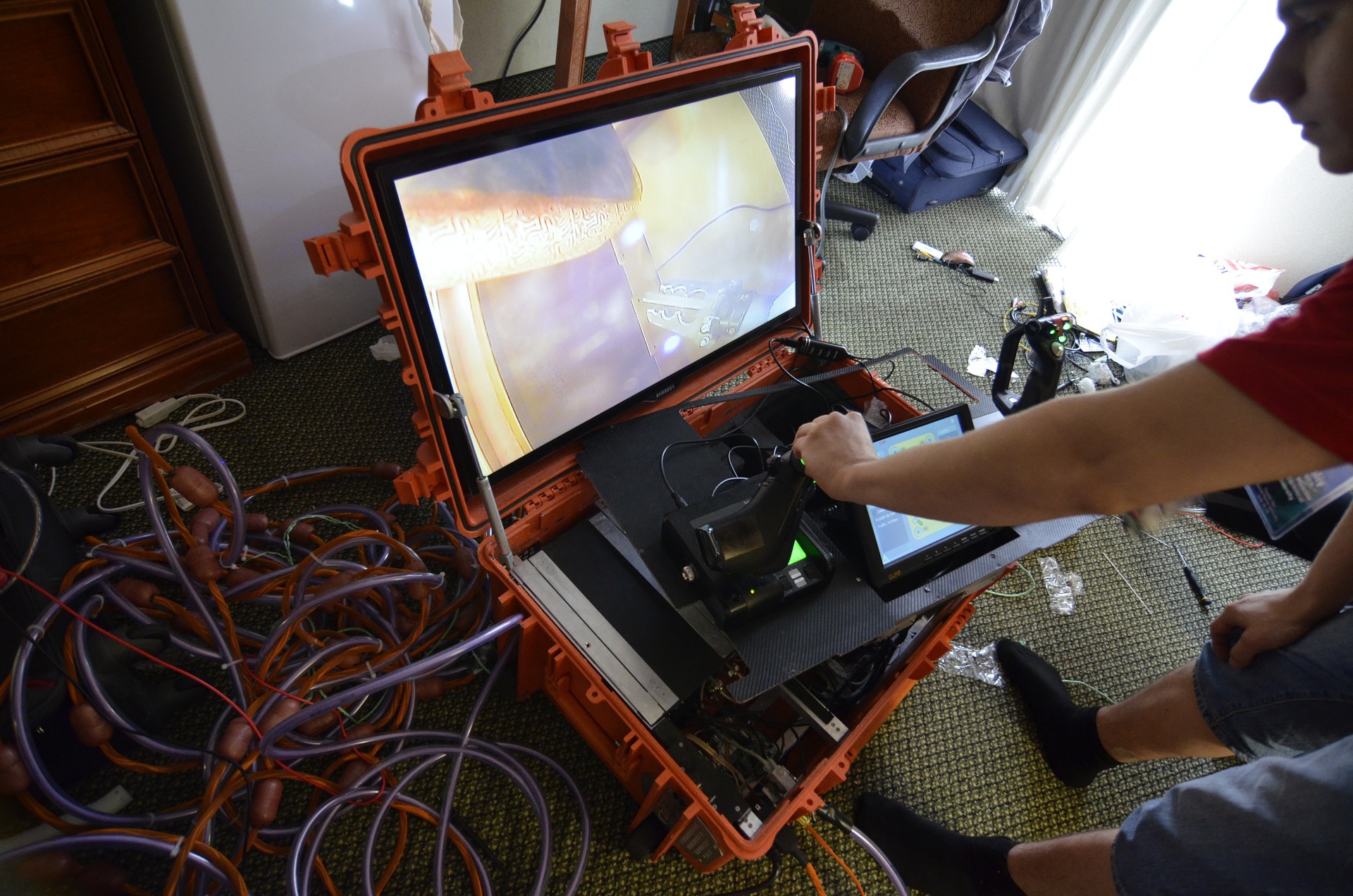
Check the video on the already assembled robot
The third day was the first day of the competition. An opening ceremony, a robots safety check and a trial 15-minute launch were scheduled for that day. We were a little late for the opening and came literally a couple of minutes before we called our team, to which the guys together shouted something in response. At that time I was already running with a camera between the tables of the teams, photographing robots and their details. Unfortunately, at that time far from all the devices were put on the tables, so nothing particularly interesting could be found, with the exception of a couple of amusing mechanisms.
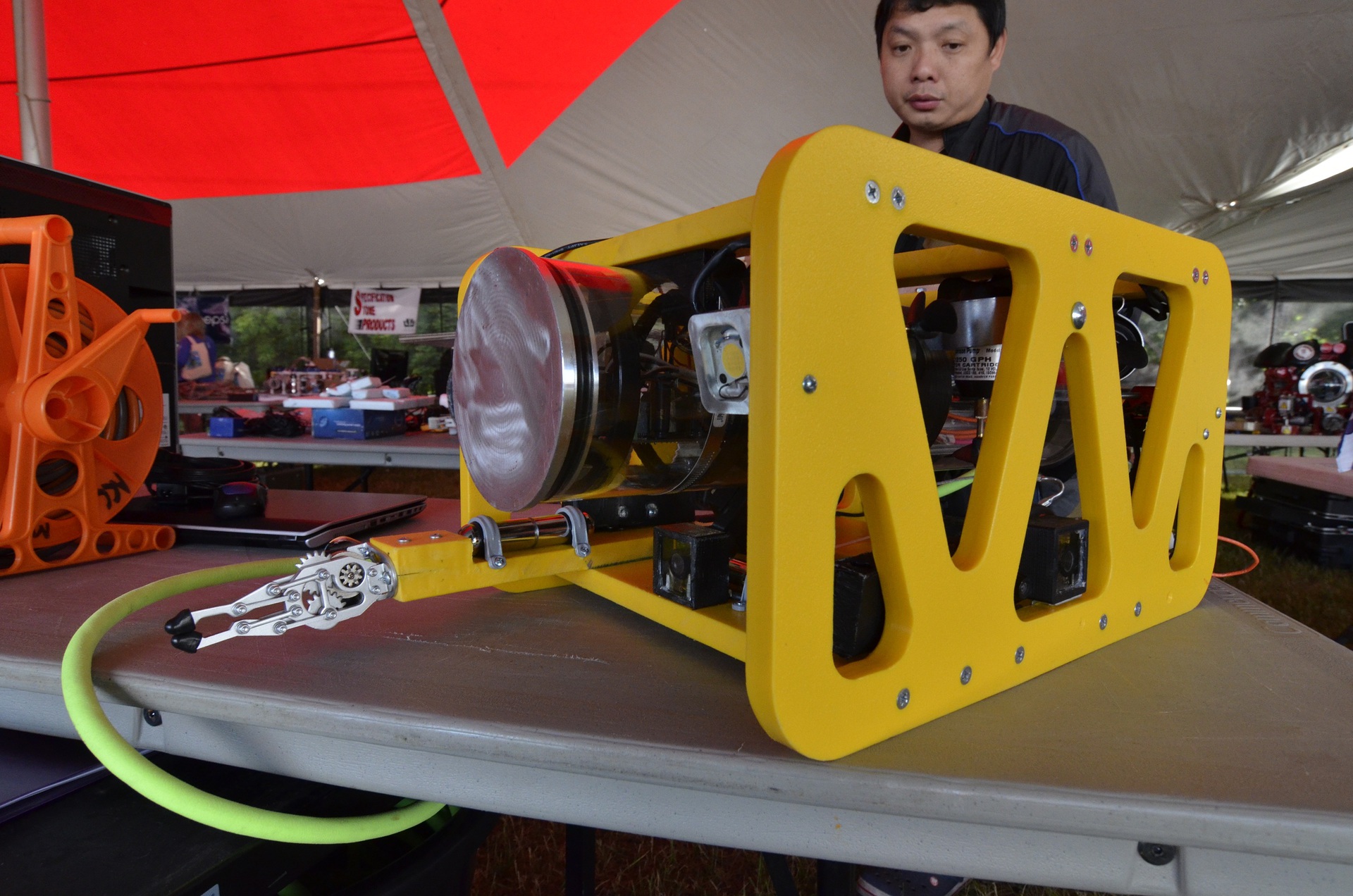
Very neat robot with an interesting grip
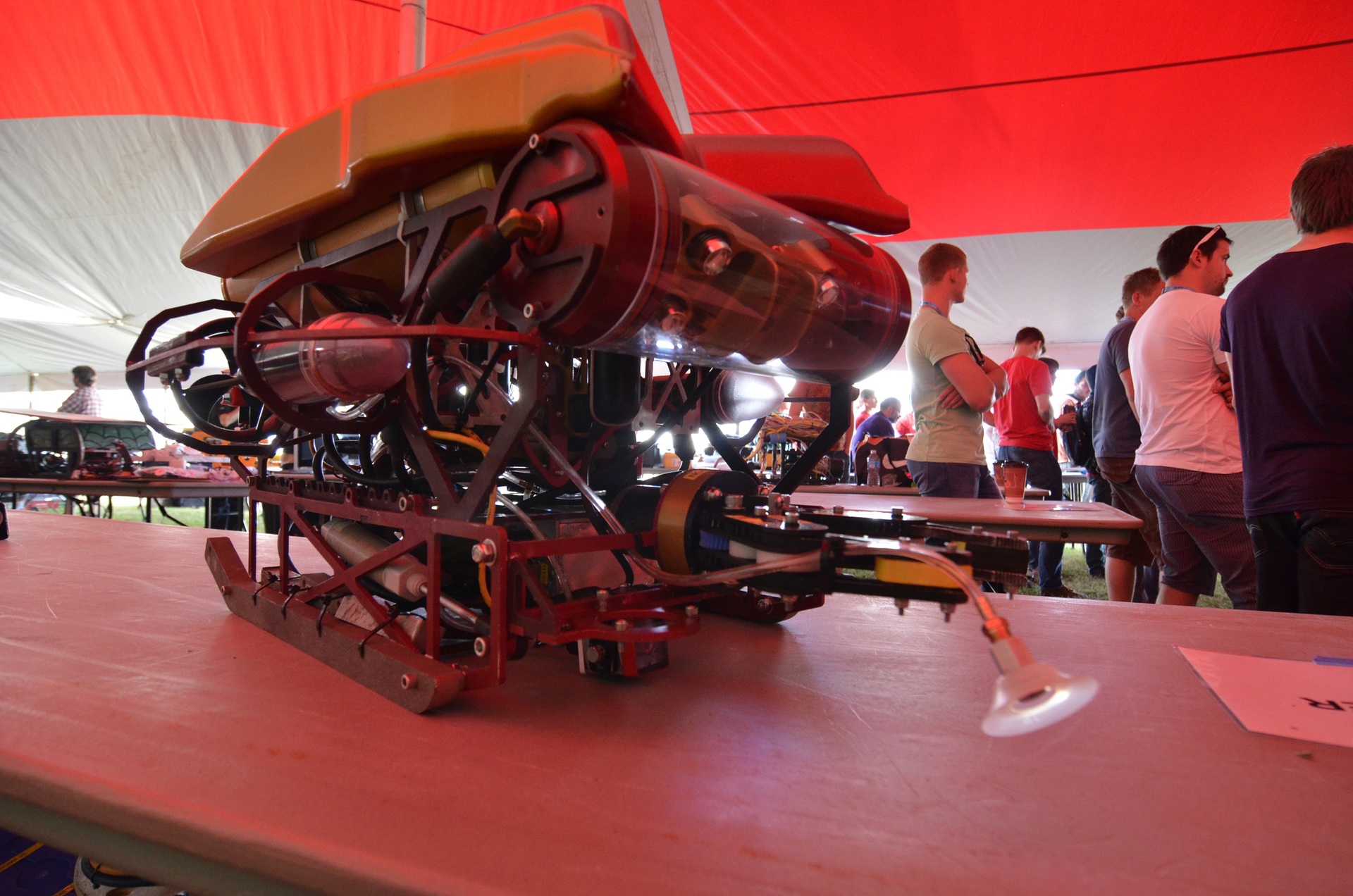
A unique robot with stylized Iron Man
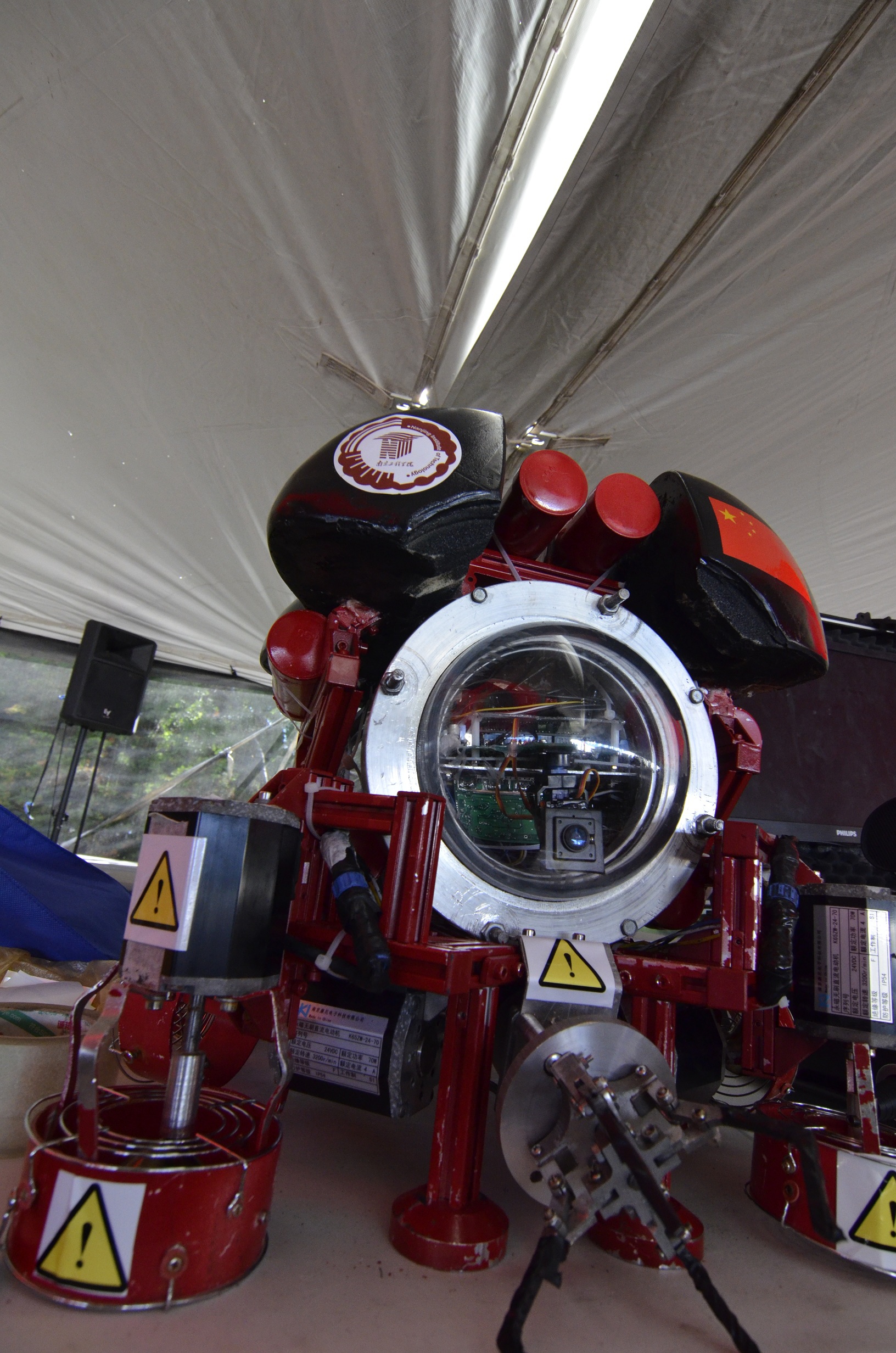
The four-finger grip and huge engines set this robot apart from the rest.
After the opening ceremony, all teams continued to prepare their robots for security checks. We were no exception. Our robot was completely plastered with warnings about sharp corners, rotating parts, and so on. Despite this, before checking we cleaned the sharp trim of the screeds, filed the sharp corners with a file so that the judges had nothing to complain about. In principle, we did everything perfectly well, so we passed both security checks without any problems.

The penultimate test passed perfectly
Satisfied with the first small success - the maximum score for the security check, we were happy to go further. As I said, several more teams lived with us in the hotel. So, the guys from Oregon agreed with the local school, which has a swimming pool, so that they allow us to swim in it. But also, being very pleasant people, they posted an announcement at the hotel that all those who also want to swim before the official test dives can come after they have agreed with them in advance. Therefore, we decided not to miss the opportunity to swim longer. Thus, after a security check, we went to school, where we tried to simulate a quick console layout and robot training. It turned out not very good, but at least swam.

Extreme workout worth its weight in gold

The lack of imitation of the competition does not matter, even just swim is good
After a while, the rest of our team arrived and it became known that the organizers had set calibration fluids to calibrate the conductivity sensors, so after a while I and a couple more people went to calibrate our conductivity meter. Arriving at the site and lowering our sensor in the provided liquids, we found an unpleasant fact, namely, our sensor was configured for a liquid with a significantly lower conductivity, while the provided liquids had a very high conductivity. Understanding the new plan for the evening, we collected samples for calibration and went to the hotel. At that time, the rest of the guys returned from school, swam for 15 minutes in a competitive pool, and also arrived at the hotel.
The evening of the first day we spent preparing for the presentation of the project, which was scheduled for the next day. In between the translations of texts for the rest of the guys and learning my passage, I calibrated the conductivity sensor and added its software. As a result, the sensor seems to have calibrated, but there was a problem with overheating: after 1-2 minutes the operational amplifier in the circuit heated up too much, which led to its failure. In principle, this was not a big problem, but it was still unpleasant.

Cool pics from divers working in the pool
The second day was the first truly competitive day, since in addition to the project presentations, other teams had real attempts on this day. We were extremely lucky and our two attempts were scattered on two different days, so if something happens, we had time to fix something and fix it. It began with a funny incident: me and my roommate were trivially forgotten in the hotel. They remembered us only when they began to check whether they took everything with them, and it turned out that there was no conductivity sensor. Just five for teamwork. In principle, this case slightly lowered the tension. About the presentation itself is nothing special to tell. We went into the tent, set up a robot, a remote control, told the prepared text, then talked to the judges in a more free form, told various interesting details of our robot.I liked the composition of judges at the presentation. All three judges are specialists with extensive experience in certain areas. For example, one of them has 25 years of experience in the field of underwater robotics. So their assessment is rather objective and it’s obviously impossible to "powder brains". But, in general, everyone was satisfied with the result and, although the assessment was not announced immediately, the sensations were extremely positive. After the presentation of the project, we had about 3 hours before the first attempt, so we went to the room, as it was necessary to finish something. Then there was something. Having entered literally 2.5 hours before the first attempt in the room, I saw a disassembled robot and the guys were drying hair of the electronics board. It turned outthat during yesterday's immersion, water leaked into our hull and it was discovered only today a couple of hours before the first attempt. So the atmosphere at that moment was, little to say, tense. But at the last moment everything was dried and put in order. Unfortunately, these days, especially at the time of the competition, it was not possible to take a lot of photos, so there is really nothing to show.
How is the attempt to perform missions. The team approaches the station, speaks with the judges, asks questions, once again listens to the rules. Then she is given 5 minutes to prepare for the assignments, that is, to connect the power, set everything up, etc.

Once again, listen to the rules before trying
After 5 minutes, the judges immediately note the main time. The team is divided into two parts. The first is at the console, the second at the side of the pool. You can not communicate with each other, the only thing that can be said is to demand to issue more cable. This was done in order to imitate the work of the apparatus at a great depth and prevent the promptings working at the pilot's side. After the end of the 15-minute mission period, the team is given 5 minutes to pack up and leave the station. If you do not have time to leave on time, you can get penalty points. You can also get penalty points if the robot is still in the water at the time of the end of the main time or something from its equipment remains at the bottom.
We began our attempt confidently and professionally. Having clearly defined the roles in advance, we all knew who was doing what, so we didn’t even really communicate with each other. However, this did not last long, at about the second minute we found that the contact of the PS / 2 connector from the joystick was bent. Screwdriver to fix this, we found quickly, but it turned out that this is only the beginning. Further, for some reason, there was no connection with the robot and it was not quite long, so the first 2 minutes from the main time we lost. Then everything was a little more successful, some missions were completed, some were not. My sensor safely fell out of the bottle due to the high center of gravity of the weighting agent. At the end of time, we quickly got together and dumped from the station. The result is 135 points - not as bad as some teams, but they could reach up to 200,affected by 2 minutes at the beginning.
By and large, all the mistakes were evident, a few minutes later a rather active discussion of them began, which continued all the way to the hotel and in the hotel itself. Our main mistake was that we didn’t check everything in advance, that is, we came from the hotel and immediately to the start, so all sorts of problems arose, such as bent connectors. Based on this, it was decided to arrive the next day a little earlier, to find a table, to collect everything there and, in the open form, carry it all to the station. Well, various small shoals, such as, for example, to lower the center of gravity on the conductivity sensor. After all this, we went to the hotel, where someone was left to finish the robot, and the rest went to the store and walk along the shore of the lake.
The second attempt, as I said, was scheduled for the third, last day of the competition at 10-30 am. Having risen a little earlier, we arrived at the site and, according to the plan, having first expanded everything and checked the robot three times, went to the start. This time we already knew what and how it would be, so we managed to prepare for 3 minutes, the rest of the time we waited for the computer to restart on the control panel. But, nevertheless, quietly waiting for the end of the download and the beginning of the main time, we started to perform tasks.
The updated conductivity sensor successfully fell into a “hydrothermal source” (salt water tank) and correctly measured the conductivity of water to my deepest surprise. Then everything went quite successfully too: they raised the anchor, swam into the ship, raised a plate with the home port - and so on. Tried to raise the bottle, but quickly left this venture. The only drawback was that it was not possible to measure correctly all the dimensions of the vessel, because of which they could not determine the number of mollusks that grew on it and lost quite a lot of points. But everything else was done quite successfully and, having managed to pull the robot out of the water at the last moment, they successfully completed the missions. The result of the second attempt is 245 points, a very unexpected result, given that we expected to reach at least two hundred points.
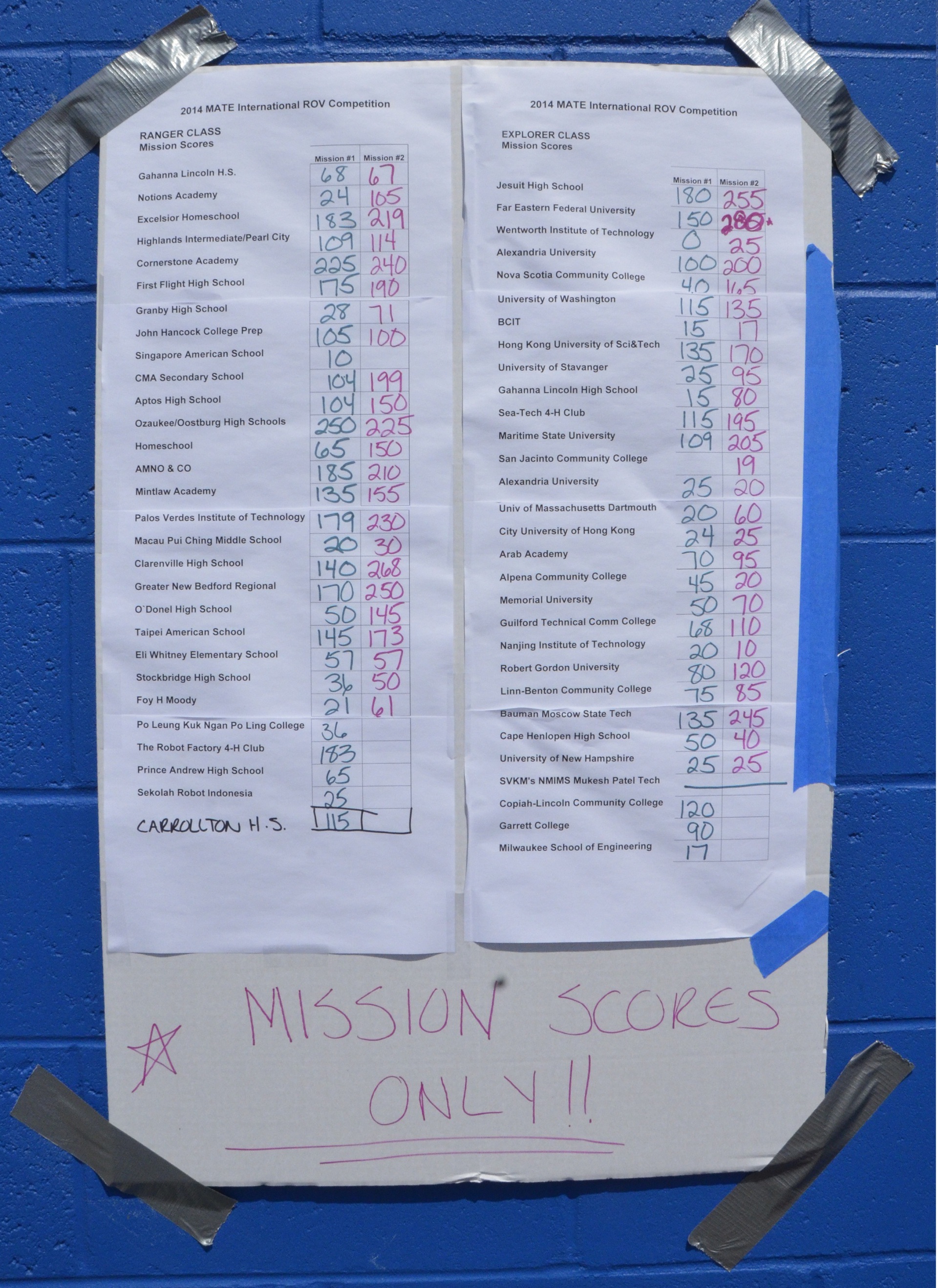
The results of two attempts. Someone never got to the second.

Our team after the second attempt.
In the evening of the same day, the winners of the competitions were awarded. An interesting feature of the competition data is a large number of nominations. Any judge can create their own nomination and select the winners. It is also interesting that prizes are awarded not only in purely technical nominations, but also in such as the best leader, the team that has overcome the most difficulties and so on. In general, it was not necessary to have a good robot to take some prize.
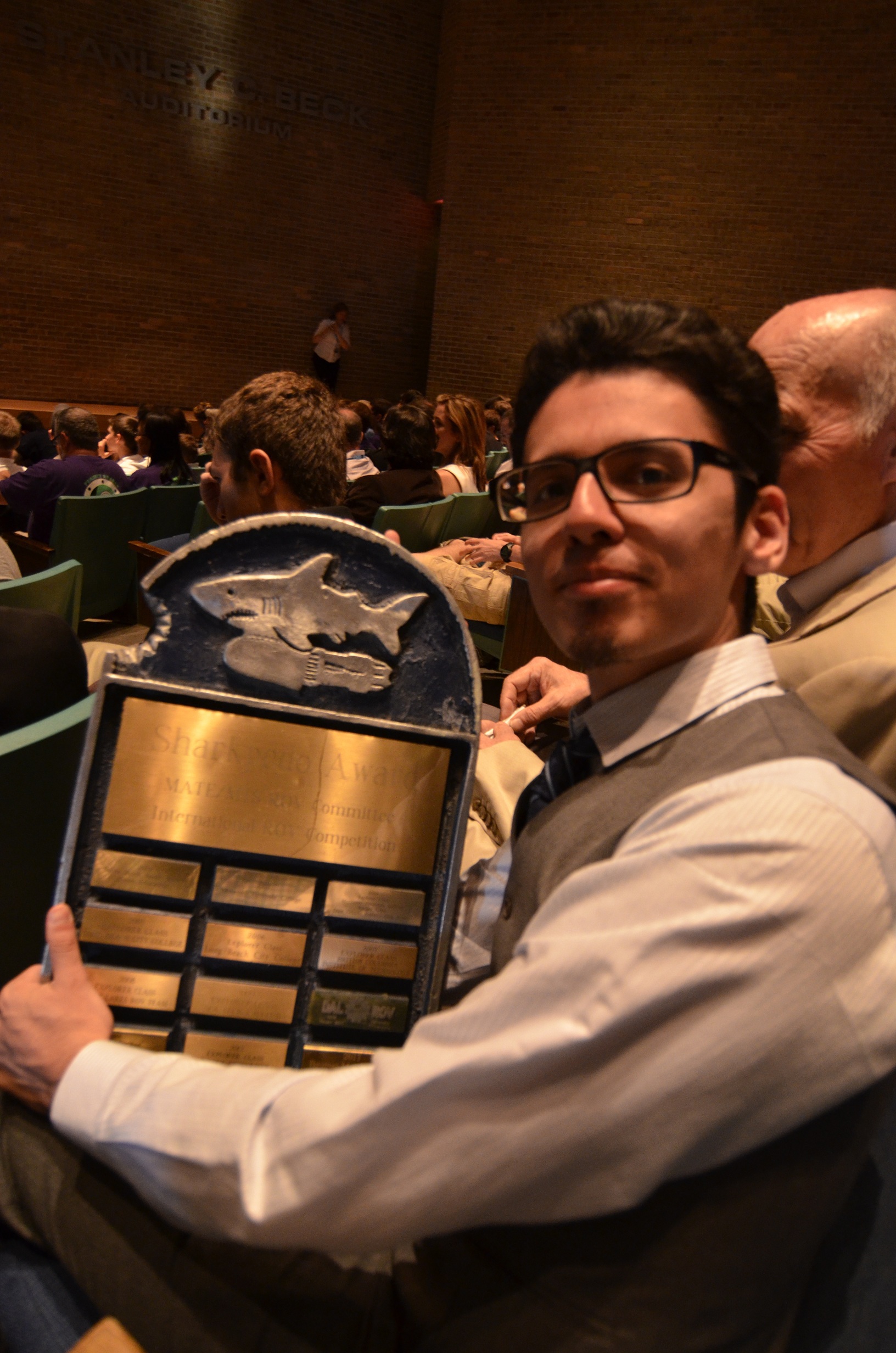
We part with the prize for innovation, received last year for the 3D vision of the robot. This year, this prize went to the team that organized the control of the device using the Oculus Rift
The results of all tests are not known in advance, so the intrigue remains until the last moment. Although, based on the results of missions, you can make some assumptions. According to the results of the missions, we were the third, therefore we were guided approximately by this place, although the end result could have been any. Our team finally got 3 prizes: in the nomination for security, a little unexpected, but quite logical result: no one had such a number of stickers on the robot. The second prize was for the best technical report, many thanks to those who ended up in Moscow, because the technical report was their business. And the third prize - for second place overall. It was also quite unexpected, but very nice, our preparation on all fronts gave its result.

Victory in the nomination "The best technical report"

Second place in the overall standings

Victory in the category “For Security”
We overtook the team from the Far East: the guys had 280 points for the missions, but the results on the remaining points were slightly worse than ours. In the first place was the team from Jesuit High School. A huge team, a man under 25 or even more, last year's winners, scored 255 points for the mission and took the prize for the best poster. The awards took place in a very family atmosphere, the presenter - one of the organizers of the competition, constantly joked and generally maintained a somewhat informal atmosphere because of what really gave the impression that we were one big family.
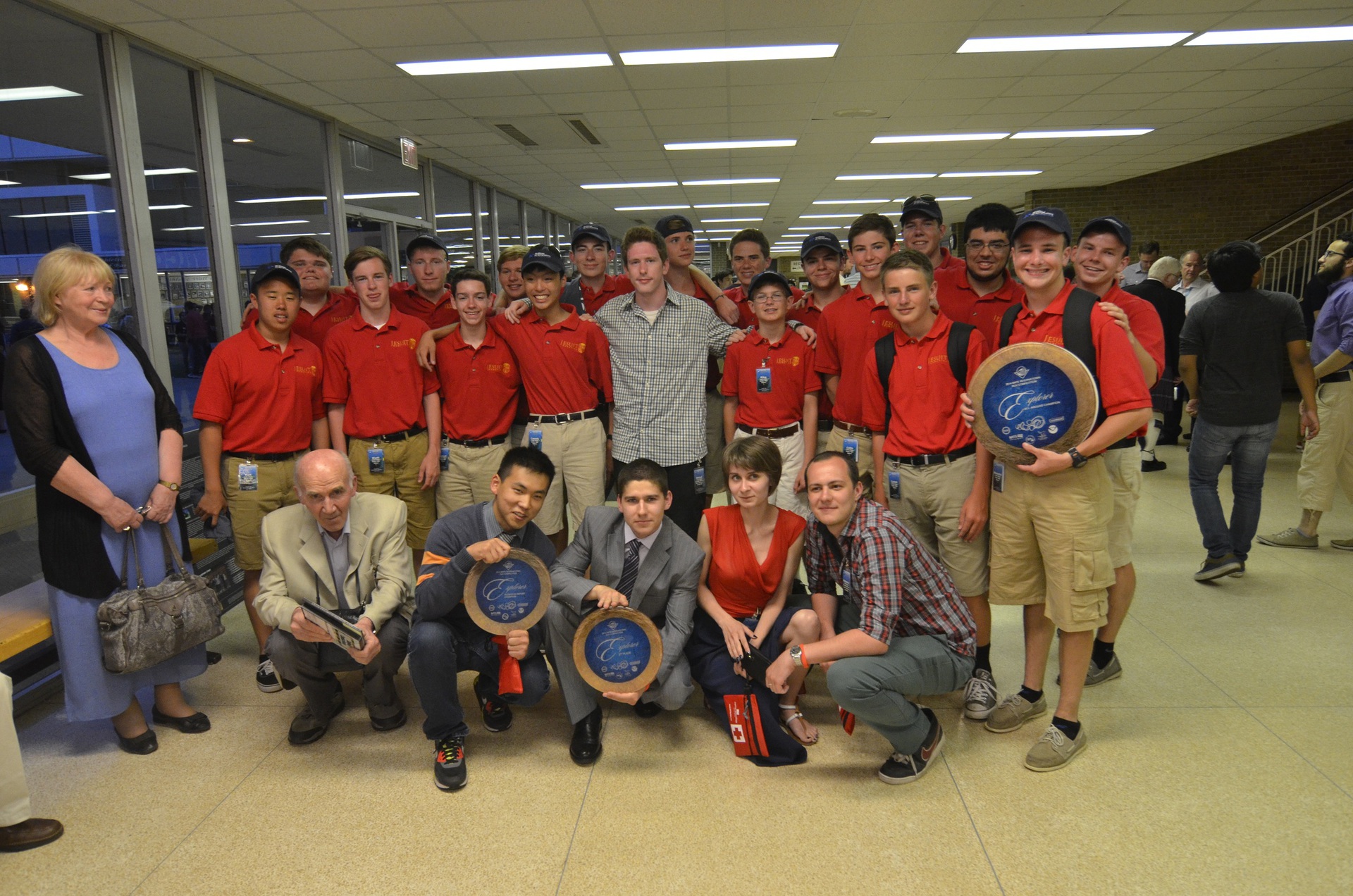
The numerical advantage of the winning team.
The awards were followed by photographing with various teams, and then a celebration that took place in the hotel.

Against the background of the Alpena school.

The received awards look good with the lighting.
On the sixth day we had to go home. Again, 5 hours by car to Detroit, then two flights to Moscow. And then someone went to rest, and someone for military training.
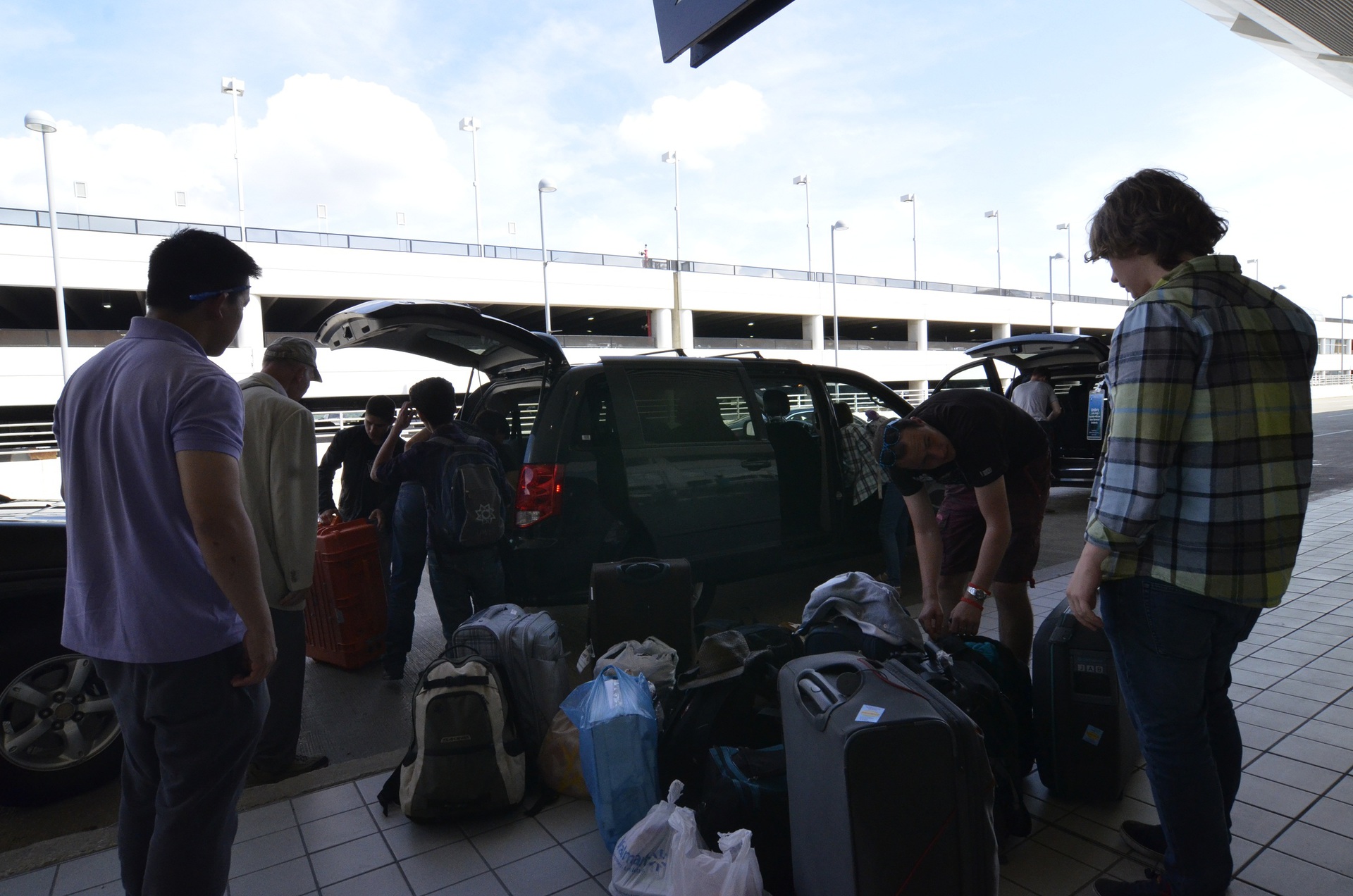
We unload and rent cars.
The result of the competition was really unexpected for everyone, because the best result of previous years was only 7th place, and this year the number of participants also increased dramatically. One way or another, we have exceeded our expectations. Of course, something could have been done better, and our lag behind the winners was not so great, but even so, for the team that performs in such a lineup for the first time, such a result is an incredible success. Perhaps the truth is newbies lucky.
At the end I would like to say that at the moment we have already begun to design a new device for the next competition. A new robot is planned to be made with new electronics, new propeller engines and generally try to do everything at a higher level. So our center continues to work on preparing for the competition next year.
Obviously, such competitions, and in particular preparation for them, provide invaluable work experience. Probably, this is exactly what is often lacking in our educational process. Therefore, I am infinitely glad that that day, six months ago, I gave a positive answer to the question about my participation in the project.
And here is a short video about the preparation and the trip itself:
Under the cut a lot of photos.
Prehistory
Our laboratory on a typical day.
My classmate is studying at the department of underwater robots at MSTU. N. E. Bauman. A little after the new year, I receive a message from him with a proposal to participate in the project of an underwater robot for the competition as a programmer of microcontrollers, due to the fact that no one in their team has ever programmed. Since I didn’t have any plans for independent work for the coming semester, I agreed with pleasure, in the end, I finally had the opportunity to do something real that you can touch and what goes beyond home crafts. It turned out that at our institute for several years now the “Hydronavtika” center has been operating, the activity of which is mainly focused on preparing and participating in competitions from the organization Marine Advanced Technology Education Center (MATE) on the subject of underwater remote-controlled vehicles (remotely operated underwater vehicle). English-language literature is traditionally abbreviated as ROV). It should be noted that the laboratory of the center is equipped in principle with everything that is needed for productive work: an oscilloscope, soldering stations, various machines and tools, as well as its own small pool with a water filtration system. Without it, it would be very difficult, because would have to run every time in the pool of the university sports complex, if necessary.
')
Tests of the robot in our home pool
After a short chat with my friend, we agreed to meet with the other guys in their lab. The guys were very nice and positive. After a brief discussion of the current state of the project and the competition itself, it was decided that I would participate.
The essence of the event
More information about the competitions can be found on the official website . In short, the competition consists of passing through several stages. First, you need to get the approval of the organizers of the competition about your participation, for this you need to prepare a number of documents, for example, a technical report with a detailed description of the device. You also need a month before the performance to provide a video with a demonstration of the apparatus, to show that he can swim at all and perform at least some tasks under water. After passing the preparatory stages and obtaining the approval of the organizers, you can go to the competition. As with all such activities, the task set changes annually.
A list of all tasks on the wall of the laboratory
Each year, competitions have a specific theme related to real problems and tasks in the waters, which require underwater vehicles to solve. This year the task was to study the bottom of one of the Great American Lakes, namely Lake Huron. At the bottom of the lake, in untouched form, there are many sunken ships. The mission of the device consisted of three stages: the study of a shipwreck, scientific research at the bottom, cleaning the bottom from debris. Of course, the competition itself is only a simulation of the real situation, so the vehicles floated not in the lake, but in a deep pool, at the bottom of which a shipwreck and other bottom equipment was displayed. In the first stage, it was necessary to investigate the shipwreck zone in order to determine the type of the ship, the year of its construction, the port of registry, which will allow it to be identified uniquely. The second stage includes such tasks as counting the number of mollusks that have grown to the surface of the ship, determining the conductivity of water spurting from an underwater source and lifting from the bottom of gel-like biomaterial samples.
Slightly stagnant and therefore moldy glasses with jelly for testing
In the third stage, it was necessary to pick up trash (glass and plastic bottles) from the bottom of the lake, as well as a heavy steel anchor of the sunken ship.
It should be noted that successfully completing all the tasks under water is not enough to win. Underwater missions “cost” only 320 points out of a total of 600. Competitions are structured in such a way that teams are required to present themselves on the site of private companies participating in a tender for underwater work. That is, each team must successfully present itself to the judges and justify why it is their staff and their team will be able to carry out the work most successfully. This part of the competition is called “Engineering and Communication” and also consists of 3 items - a technical report, an engineering presentation and a poster.
The technical report is a 25-page document containing a detailed description of the apparatus and the process of its development, its technical features (“features”), which will ensure the successful fulfillment of the underwater mission. This document must be prepared about a month before the competition and sent to the judges. For technical report you can get up to 100 points.
On the poster, the team should be concise, but colorfully fit the information about the team and the staff. Posters are also evaluated by the judges during the competition, for them the team can get up to 50 points.
Engineering presentation is an oral presentation of the team in front of a panel of expert judges, with a story about the advantages of the device over its competitors. The presentation is worth 100 points.
The remaining 30 points are given to those teams that from the first time passed the test of their apparatus for safety and compliance with the regulations.
Thus, only careful preparation of all points can bring the team victory.
Start of development
At the time of accepting me into the project, and let me remind you, it was somewhere the beginning of February or even later, things were not too good: the previous team graduated, and only 2 people were left from it, who at least somehow imagined how everything should be. The new team, unfortunately, was practically without work experience, for many it was the first real project. The old team left behind a working robot, and working perfectly. But, unfortunately, participation in the competition with one robot two times in a row is not welcome, so the task of the new team was to develop and assemble a new robot. Also, the first semester of this academic year was spent almost completely empty, and only half a year was left before the competition, which, given the general academic load, is quite a short time.
My tasks in the project included writing software for on-board electronics, which was based on the Arduino platform. This choice was justified by the fact that most of the participants only learned programming, and such a platform was the best choice. I, as an amateur of pure MK programming, although at first resisted, but in the end I agreed with this choice, since all the boards were already developed for the Arduin and there was no time left to change something.
Actually, this is how it all started, unfortunately, for quite a long time I was up to date and only after almost a month and a half until the end I understood how everything should look in the end. Again, the study load, which did not allow to work in full force, affected.
Now a little about the technical details. The electronics of our robot was a tower of several round printed double-sided boards, placed a cylindrical plexiglass case, closed on both sides with sealed covers.
Two parts of the electronics tower in parsing
Fastening the covers of the electronics housing occurs without screws, thus assembling / disassembling can be done quite quickly. All boards have the same connectors with the same pinout, thus eliminating the possibility of improper assembly. This concept was taken from the previous robot and, in my opinion, is very convenient in this situation. The tower consists of the main controller board — the Arduino Mega, the screw driver driver board, the secondary power supply board, the fixture control board (manipulators, light, pressure sensor, camera drive), two interface boards with sealed connectors, one on each side. The robot itself has 8 rotor motors located vectorially: 4 vertical, 4 horizontal.
Upper part of the body of the robot. One vertical and two horizontal propellers are visible.
There is also a camera box in which there are 2 cameras, one for the pilot, one for the image processing system. Also there are 2 manipulators and light.
Camera body, still raw version
Orientation in space and stabilization is performed using a Vectornav VN-100 sensor. Communication with the robot takes place via the RS-485 interface, using a simple protocol developed by us. There is also a control panel, left over from the previous command, with 2 kW power supplies, built-in PC, 3D monitor for video from cameras and a small touch screen for drawing the dashboard.
Remote Control
Parallel to the development, assembly and testing of various parts of the robot, there was registration for competitions, documentation, and so on. In early May, we had an interview at the US embassy to get a visa. This event was significant not only because most of us sent for an additional check, but also because the next day I learned that due to the fact that we did not have time to finish and debug the current electronics, it was decided to use electronics from previous robot, as it is fully operational. In principle, the decision was quite logical, although it was a bit annoying, since by that time the new electronics was 60-70 percent ready, that is, it was the orientation, controls of the screw motors, grippers, lights, camera positions.
The result of several months of work remaining in Moscow. Tulip inside turned out to be random
But there was a wrong situation to defend my results, so I was quickly transferred to another task - the conductivity sensor. At the beginning it was assumed that this would be a small unit with a sensor sticking out of it, which the pilot would install in an imitation of a hydrothermal source. However, later the design was slightly changed, leaving the data processing unit on the shore, and only the sensor cell was lowered to the bottom. For those who do not know, the water conductivity sensor consists of two graphite rods, between which alternating current is allowed. Variable — to prevent ions from sticking to the rods. Then, from one rod, this alternating voltage is fed through a diode to the ADC, where the voltage level is measured and further processed to obtain the conductivity value. They did the circuit design themselves - they assembled it on a breadboard, they looked at how it seemed to work. I was required to write the software for the arduine of the nano standing in the block, that is, to organize the measurement of the voltage level through the ADC and the delivery of this data to a computer, for which I also had to write the software for display on the screen. It was also necessary to place a temperature sensor inside the conductivity sensor to adjust the conductivity value.
Conductor measuring device just completed
The funny thing is that almost before leaving and after the heap of time spent on making the temperature sensor work normally, it turned out that it is not needed, since the condition requires determining conductivity in general, at the current time, and this value does not depend on temperature . In principle, it was one of the many shoals we committed while working on the project. Despite the simplicity of the sensor, I spent a lot of time on it. Since, in addition to a slightly clumsy analog circuit, it seems that there was some kind of life of its own, there were a lot of other problems, such as the temperature sensor and glitches of the USB-UART adapter. The software for processing data from the sensor was done literally until the last moment, but more on that later.
After the robot was assembled (mid-end of May), we went swimming in the pool several times, then we must thank the administration of our university for contributing to the allocation of paths in the pool of the sports complex.
Final option
Workout shortly before departure. The main thing was not to forget slippers
There were a lot of problems on the test: leaks, loss of communication and burned-down boards. So, once the video link disappeared. Having examined the block of cameras, they saw a dead diode on the video signal conversion board of the video camera. The solution is to replace the cable with a shielded twisted pair. It also eliminated noise in the analog video signal.
Once a leak caused a complete burnout of the power tracks on the driver and, accordingly, the engine shutdown. We noticed it not immediately, because the robot remained operational, there was simply no thrust through the lag (the lag is a plane-parallel movement along the transverse axis). At first they thought that the screw flew off the shaft mounting, however, when they came to the laboratory, they found that everything was much sadder.
Burnt from KZ short circuits
And so on. As a result, it turned out that at the time of departure we could not conduct a single full-fledged training of the team and the execution of all the missions for the time set. It was also interesting that during the training sessions in our pool, the pilot constantly had to cope with undercurrents, which were often quite strong and very much hampered the execution of tasks. But, as it turned out, it was difficult to learn - it was easy to fight, and there were no currents in the pool where the competitions took place, so it was much easier for our pilot to complete the tasks.
Departure for a combat mission
The week before departure, as expected, was quite intense. Besides the fact that many had exams, it was necessary to still prepare for departure. Various devices, details of the robot, my sensor and a lot of other things were quickly completed. On the day of departure, while the guys were sorting out and packing the robot in their suitcases, I went shopping to buy more trash.
Packing suitcases. It is very important that everything is intact.
It's funny that both times, when I left the university, I fell under a wild downpour, which ended after 20 minutes. We had a plane at five in the morning, so we spent the whole previous day collecting in the laboratory to go to the airport at night and fly away in the morning. In addition to the robot, we carried tools, an oscilloscope, a set of spare parts for the robot, and a whole lot more. I was very worried about overloading, because the dynamometer on that day was one of the main tools. The guys urgently printed a poster and prepared the documents that we will show to the judges. In the end, after reaching the university car to Sheremetyevo and meeting the rest of the guys there, having safely handed over our suitcases to the luggage, having paid a couple of overloads, we flew to Amsterdam.
5 hours before departure
In Amsterdam, a very short transfer was waiting for us; in the end, after a light jog from one gate to another and a relaxed conversation with security officers, we ended up on a plane flying to Detroit.
Competitions are held every year in the new city, the last time they were in the Federal Way town in the suburbs of Seattle, this time we were less fortunate and the provincial town of Alpena in northern Michigan, right on the shore of Lake Huron, was waiting for us. For me, this was the first visit to America and, unlike most people visiting this country for the first time, my acquaintance with it began with the real heartland.
10 thousand people live in Alpena, which is almost ten times less than in my hometown. So the international competition of this level for the city was really a big event. I will not describe my impressions of what I saw, I think it will interest few people. I will say one thing: I really liked the city and its inhabitants. Maybe the Americans are smiling at everyone, but the people we met on the street, having learned that we are one of the teams, and even more so from Russia, smiled and sincerely wished us luck.
So, arriving in Detroit, we quickly took 2 rented cars and drove to Alpena. After almost 5 hours, the roads finally reached our hotel. Since Alpena is a tiny town, there are only two hotels, in which the participants of the competition are located quite evenly. Teams from America, Indonesia, China and Canada lived with us in the hotel. The first day was completely busy assembling a robot. Each team did it in its own way: who was lucky and whose numbers went inside, settled right in the interior, who were not lucky and the rooms were outside, collected the robot in the rooms.
These guys are lucky, they have a big table and a lot of space.
We were less fortunate. As expected, one room turned into a small workshop, where someone was always doing something.
Although we do not have a large table, but it was cozier
In the absence of an accessible pool, the sealing of the robot was checked in the bathroom.
We spent the entire first and second days at the hotel, collecting robots and gadgets for it, only having gone to eat a couple of times, to the store for details and to register.
Check the video on the already assembled robot
The third day was the first day of the competition. An opening ceremony, a robots safety check and a trial 15-minute launch were scheduled for that day. We were a little late for the opening and came literally a couple of minutes before we called our team, to which the guys together shouted something in response. At that time I was already running with a camera between the tables of the teams, photographing robots and their details. Unfortunately, at that time far from all the devices were put on the tables, so nothing particularly interesting could be found, with the exception of a couple of amusing mechanisms.
Very neat robot with an interesting grip
A unique robot with stylized Iron Man
The four-finger grip and huge engines set this robot apart from the rest.
After the opening ceremony, all teams continued to prepare their robots for security checks. We were no exception. Our robot was completely plastered with warnings about sharp corners, rotating parts, and so on. Despite this, before checking we cleaned the sharp trim of the screeds, filed the sharp corners with a file so that the judges had nothing to complain about. In principle, we did everything perfectly well, so we passed both security checks without any problems.
The penultimate test passed perfectly
Satisfied with the first small success - the maximum score for the security check, we were happy to go further. As I said, several more teams lived with us in the hotel. So, the guys from Oregon agreed with the local school, which has a swimming pool, so that they allow us to swim in it. But also, being very pleasant people, they posted an announcement at the hotel that all those who also want to swim before the official test dives can come after they have agreed with them in advance. Therefore, we decided not to miss the opportunity to swim longer. Thus, after a security check, we went to school, where we tried to simulate a quick console layout and robot training. It turned out not very good, but at least swam.
Extreme workout worth its weight in gold
The lack of imitation of the competition does not matter, even just swim is good
After a while, the rest of our team arrived and it became known that the organizers had set calibration fluids to calibrate the conductivity sensors, so after a while I and a couple more people went to calibrate our conductivity meter. Arriving at the site and lowering our sensor in the provided liquids, we found an unpleasant fact, namely, our sensor was configured for a liquid with a significantly lower conductivity, while the provided liquids had a very high conductivity. Understanding the new plan for the evening, we collected samples for calibration and went to the hotel. At that time, the rest of the guys returned from school, swam for 15 minutes in a competitive pool, and also arrived at the hotel.
The evening of the first day we spent preparing for the presentation of the project, which was scheduled for the next day. In between the translations of texts for the rest of the guys and learning my passage, I calibrated the conductivity sensor and added its software. As a result, the sensor seems to have calibrated, but there was a problem with overheating: after 1-2 minutes the operational amplifier in the circuit heated up too much, which led to its failure. In principle, this was not a big problem, but it was still unpleasant.

Cool pics from divers working in the pool
The second day was the first truly competitive day, since in addition to the project presentations, other teams had real attempts on this day. We were extremely lucky and our two attempts were scattered on two different days, so if something happens, we had time to fix something and fix it. It began with a funny incident: me and my roommate were trivially forgotten in the hotel. They remembered us only when they began to check whether they took everything with them, and it turned out that there was no conductivity sensor. Just five for teamwork. In principle, this case slightly lowered the tension. About the presentation itself is nothing special to tell. We went into the tent, set up a robot, a remote control, told the prepared text, then talked to the judges in a more free form, told various interesting details of our robot.I liked the composition of judges at the presentation. All three judges are specialists with extensive experience in certain areas. For example, one of them has 25 years of experience in the field of underwater robotics. So their assessment is rather objective and it’s obviously impossible to "powder brains". But, in general, everyone was satisfied with the result and, although the assessment was not announced immediately, the sensations were extremely positive. After the presentation of the project, we had about 3 hours before the first attempt, so we went to the room, as it was necessary to finish something. Then there was something. Having entered literally 2.5 hours before the first attempt in the room, I saw a disassembled robot and the guys were drying hair of the electronics board. It turned outthat during yesterday's immersion, water leaked into our hull and it was discovered only today a couple of hours before the first attempt. So the atmosphere at that moment was, little to say, tense. But at the last moment everything was dried and put in order. Unfortunately, these days, especially at the time of the competition, it was not possible to take a lot of photos, so there is really nothing to show.
How is the attempt to perform missions. The team approaches the station, speaks with the judges, asks questions, once again listens to the rules. Then she is given 5 minutes to prepare for the assignments, that is, to connect the power, set everything up, etc.
Once again, listen to the rules before trying
After 5 minutes, the judges immediately note the main time. The team is divided into two parts. The first is at the console, the second at the side of the pool. You can not communicate with each other, the only thing that can be said is to demand to issue more cable. This was done in order to imitate the work of the apparatus at a great depth and prevent the promptings working at the pilot's side. After the end of the 15-minute mission period, the team is given 5 minutes to pack up and leave the station. If you do not have time to leave on time, you can get penalty points. You can also get penalty points if the robot is still in the water at the time of the end of the main time or something from its equipment remains at the bottom.
We began our attempt confidently and professionally. Having clearly defined the roles in advance, we all knew who was doing what, so we didn’t even really communicate with each other. However, this did not last long, at about the second minute we found that the contact of the PS / 2 connector from the joystick was bent. Screwdriver to fix this, we found quickly, but it turned out that this is only the beginning. Further, for some reason, there was no connection with the robot and it was not quite long, so the first 2 minutes from the main time we lost. Then everything was a little more successful, some missions were completed, some were not. My sensor safely fell out of the bottle due to the high center of gravity of the weighting agent. At the end of time, we quickly got together and dumped from the station. The result is 135 points - not as bad as some teams, but they could reach up to 200,affected by 2 minutes at the beginning.
By and large, all the mistakes were evident, a few minutes later a rather active discussion of them began, which continued all the way to the hotel and in the hotel itself. Our main mistake was that we didn’t check everything in advance, that is, we came from the hotel and immediately to the start, so all sorts of problems arose, such as bent connectors. Based on this, it was decided to arrive the next day a little earlier, to find a table, to collect everything there and, in the open form, carry it all to the station. Well, various small shoals, such as, for example, to lower the center of gravity on the conductivity sensor. After all this, we went to the hotel, where someone was left to finish the robot, and the rest went to the store and walk along the shore of the lake.
The second attempt, as I said, was scheduled for the third, last day of the competition at 10-30 am. Having risen a little earlier, we arrived at the site and, according to the plan, having first expanded everything and checked the robot three times, went to the start. This time we already knew what and how it would be, so we managed to prepare for 3 minutes, the rest of the time we waited for the computer to restart on the control panel. But, nevertheless, quietly waiting for the end of the download and the beginning of the main time, we started to perform tasks.
The updated conductivity sensor successfully fell into a “hydrothermal source” (salt water tank) and correctly measured the conductivity of water to my deepest surprise. Then everything went quite successfully too: they raised the anchor, swam into the ship, raised a plate with the home port - and so on. Tried to raise the bottle, but quickly left this venture. The only drawback was that it was not possible to measure correctly all the dimensions of the vessel, because of which they could not determine the number of mollusks that grew on it and lost quite a lot of points. But everything else was done quite successfully and, having managed to pull the robot out of the water at the last moment, they successfully completed the missions. The result of the second attempt is 245 points, a very unexpected result, given that we expected to reach at least two hundred points.
The results of two attempts. Someone never got to the second.
Our team after the second attempt.
In the evening of the same day, the winners of the competitions were awarded. An interesting feature of the competition data is a large number of nominations. Any judge can create their own nomination and select the winners. It is also interesting that prizes are awarded not only in purely technical nominations, but also in such as the best leader, the team that has overcome the most difficulties and so on. In general, it was not necessary to have a good robot to take some prize.
We part with the prize for innovation, received last year for the 3D vision of the robot. This year, this prize went to the team that organized the control of the device using the Oculus Rift
The results of all tests are not known in advance, so the intrigue remains until the last moment. Although, based on the results of missions, you can make some assumptions. According to the results of the missions, we were the third, therefore we were guided approximately by this place, although the end result could have been any. Our team finally got 3 prizes: in the nomination for security, a little unexpected, but quite logical result: no one had such a number of stickers on the robot. The second prize was for the best technical report, many thanks to those who ended up in Moscow, because the technical report was their business. And the third prize - for second place overall. It was also quite unexpected, but very nice, our preparation on all fronts gave its result.

Victory in the nomination "The best technical report"

Second place in the overall standings

Victory in the category “For Security”
We overtook the team from the Far East: the guys had 280 points for the missions, but the results on the remaining points were slightly worse than ours. In the first place was the team from Jesuit High School. A huge team, a man under 25 or even more, last year's winners, scored 255 points for the mission and took the prize for the best poster. The awards took place in a very family atmosphere, the presenter - one of the organizers of the competition, constantly joked and generally maintained a somewhat informal atmosphere because of what really gave the impression that we were one big family.
The numerical advantage of the winning team.
The awards were followed by photographing with various teams, and then a celebration that took place in the hotel.
Against the background of the Alpena school.
The received awards look good with the lighting.
On the sixth day we had to go home. Again, 5 hours by car to Detroit, then two flights to Moscow. And then someone went to rest, and someone for military training.
We unload and rent cars.
The result of the competition was really unexpected for everyone, because the best result of previous years was only 7th place, and this year the number of participants also increased dramatically. One way or another, we have exceeded our expectations. Of course, something could have been done better, and our lag behind the winners was not so great, but even so, for the team that performs in such a lineup for the first time, such a result is an incredible success. Perhaps the truth is newbies lucky.
At the end I would like to say that at the moment we have already begun to design a new device for the next competition. A new robot is planned to be made with new electronics, new propeller engines and generally try to do everything at a higher level. So our center continues to work on preparing for the competition next year.
Obviously, such competitions, and in particular preparation for them, provide invaluable work experience. Probably, this is exactly what is often lacking in our educational process. Therefore, I am infinitely glad that that day, six months ago, I gave a positive answer to the question about my participation in the project.
And here is a short video about the preparation and the trip itself:
Source: https://habr.com/ru/post/236961/
All Articles